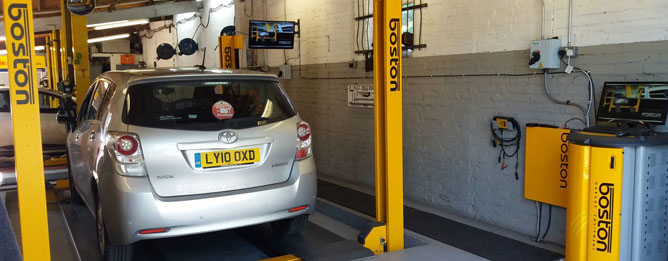Call us on 0208 302 0600 | derek@tech-one.co.uk
Call us on 0208 302 0600 | derek@tech-one.co.uk

All MoT work undertaken including welding and emission faults!
If you’ve been happily ignoring a warning light because its not checked in the MoT you could soon be facing an MoT failure and an expensive repair bill because of changes to the test.
From 1st January 2012, the Department for Transport added several new mandatory test items to the annual MoT to comply with a revised European testing directive.
The aim of the revised directive (2009/40/EC) is to harmonise minimum test requirements across Europe and make sure the test reflects the electrical/electronic complexity of modern car safety features.
The new testable components are currently subject to a bedding in period during which any defects found in these components will be advisory only.
The main changes are listed below:
Electronic Parking Brake
Electronic parking brake controls are now included and must be present and not inappropriately repaired or modified – repair obviously likely to adversely affect the roadworthiness of the vehicle or modification that has seriously weakened the component.
(The inappropriately repaired or modified check is to be applied to a wide range of systems and components throughout the vehicle.)
The car will fail if an Electronic Parking Brake warning lamp is illuminated to indicate a malfunction.
Electronic Stability Control
Checks of antilock brakes will be extended to include Electronic Stability Control if fitted. The tester will check for the presence and correct operation of the ESC malfunction warning light together with looking for obviously missing, excessively damaged or inappropriately repaired or modified components and electrical wiring, as well as an ESC switch missing, insecure or faulty.
Warning Lights
As well as electronic parking brake and electronic stability control warning lights (where fitted) the MOT test will also include checks for the correct function of the following, where fitted;
Headlight main beam warning light
Electronic power steering warning light
Brake fluid level warning light
Seat belt pre-tensioner warning light
Steering & Suspension
The new test includes a check on the presence and correct function of the steering lock where fitted as standard.
Missing, or split/damaged dust covers on steering and suspension ball-joints will result in failure if they will allow dirt to enter the joint.
Power steering fluid level must be above the minimum level indicated on the reservoir.
Lighting
Products on the lens or light source that obviously reduce the lights intensity or change its colour will become a reason for failure – applies to front/rear position lamps, registration plate lamps, stop lamps, rear fog and direction indicators,
Headlight requirements are updated to take account of the particular characteristics of High Intensity Discharge (HID) lamps.
HID headlights can cause dazzle if they are dirty or aimed too high, so they are generally (if light output exceeds 2000 lumens) fitted in conjunction with headlamp cleaning and levelling systems. Where HID or LED dipped beam headlamps are fitted the tester will switch on the headlamps and check the operation of any headlamp levelling and cleaning devices fitted.
The car will fail if a headlamp levelling or cleaning device is inoperative or otherwise obviously defective.
If a headlamp bulb is not seated correctly the resulting beam pattern will be indistinct and this will result in a test fail.
Electrical Wiring and Battery
An unsecured battery will be a reason for failure as will a battery that is leaking electrolyte.
Visible wiring that is insecure, inadequately supported or likely to cause a short will also result in a failure as will wires bared by damaged insulation.
Trailer/Caravan Electrical Socket
There will be a basic security/damage check of 7-pin sockets. 13-pin sockets will be subject to a full electrical connectivity check, and incorrectly connected or inoperative circuits will result in failure.
Tyres
Tyre pressure monitoring systems fitted to vehicles first registered after 1st January 2012 must be working correctly and not indicating a malfunction.
Supplementary Restraints & Airbags
The vehicle will fail the test if any airbag fitted as original equipment is obviously missing or defective.
A seatbelt pre-tensioner fitted as original equipment but missing or that has obviously deployed will be a reason for failure.
Seatbelt load limiters that are missing where fitted as standard or folding webbing type limiters that have obviously deployed are also reasons for failure.
The vehicle will also fail if a Supplementary Restraint System (SRS) malfunction indicator lamp indicates a system malfunction.
Speedometer
The car will fail if a speedometer is not fitted, is incomplete, inoperative, has a dial glass broken/missing or cannot be illuminated.
Seats
It must be possible to secure the drivers seat fore and aft adjustment mechanism in two or three different positions. On electric seats the motors must move the seat fore and aft.
Doors
A rear door that cannot be opened from the outside using the relevant control is a new reason for failure.
Doors must be easy to open and close – hinges, catches and pillars will be inspected.
Towbars
Inappropriate repair or modification to the towbar assembly will be a reason for failure if judged likely to affect the roadworthiness of the vehicle/trailer.
Exhaust
A catalytic converter fitted as original equipment but missing will be a reason for failure.
Fuel system
Damaged or chafed fuel pipes will result in failure.
(Updated 2nd October 2012)
For the latest MoT rules and regulations please check out the link below: